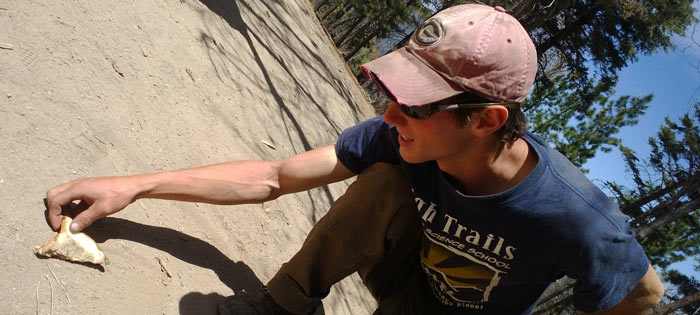 Here at High Trails, it is apparent to us that most of our students have had no real contact with nature before their experience with us.
Here at High Trails, it is apparent to us that most of our students have had no real contact with nature before their experience with us.
One of my students recently commented that the trees, freshly adorned with vibrant clumps of snow, looked like high-definition TV.
This viewpoint is a common one among our students, and it reflects a general environmental ignorance, especially among the predominantly urban youth that we teach.
Their minds are shaped by the words and images around them, and this culture perceives nature as a separate entity, an antithesis to humanity. It dictates that the wilderness is a place to test ourselves, to survive, rather than a place that can enrich our lives. TV shows such as Man vs Wild and Survivorman perpetuate the human/nature dichotomy in their names alone.
 This idea is summed up and explored further in Richard Louv’s bestseller Last Child in the Woods: “Our institutions, urban/suburban design, and cultural attitudes unconsciously associate nature with doom−while disassociating the outdoors from joy and solitude.” You don’t have to read this book, however, to notice that today’s children are increasingly separated from nature and thus believe that it is a scary place apart from their reality. Who can blame them? It is entirely natural for children to fear what they don’t know.
This idea is summed up and explored further in Richard Louv’s bestseller Last Child in the Woods: “Our institutions, urban/suburban design, and cultural attitudes unconsciously associate nature with doom−while disassociating the outdoors from joy and solitude.” You don’t have to read this book, however, to notice that today’s children are increasingly separated from nature and thus believe that it is a scary place apart from their reality. Who can blame them? It is entirely natural for children to fear what they don’t know.
As I noted in the previous post, big-picture lessons are not explicitly taught. Still, we emphasize nature as friend rather than foe in many different areas of our program. It starts just minutes after the students exit the bus when we have everyone sit on the ground. Initially we hear complaints, but when they finally sit down and learn that getting dirty isn’t the end of the world, the “dirty classroom” mentality is ingrained for the rest of the week.
I like to emphasize a similar point when students drop food while eating outside. As soon as it touches dirt, that formerly edible piece of bread might as well be radioactive to the students. So I pick it up, inspect it, and promptly eat it while making sure to thoroughly explain the difference between chemical contamination and a little bit of dirt. Most kids then understand that, though the ground may be dirty, it’s not necessarily unsafe, and that it’s perfectly okay for dirt and humans to mingle. As Rachel Carson wrote over forty years ago in Silent Spring, “Man, however much he may like to pretend the contrary, is part of nature.”
 Even though the Man vs Wild mentality is something we try and combat, we would be fools not to take advantage of it. Outdoor survival is something our students can relate to from TV, so they always get excited about it. On Outdoor Survival Hike, students learn about the rule of 3s, that is, how long an average human could survive without basic needs like water or air. The class also includes a favorite activity: survival shelter building!
Even though the Man vs Wild mentality is something we try and combat, we would be fools not to take advantage of it. Outdoor survival is something our students can relate to from TV, so they always get excited about it. On Outdoor Survival Hike, students learn about the rule of 3s, that is, how long an average human could survive without basic needs like water or air. The class also includes a favorite activity: survival shelter building!
 Yet, no class on outdoor survival would be complete without mentioning the fact that it’s best not to get lost in the first place. “Plan your hike,” we say, “and hike your plan!” We make sure to emphasize the importance of bringing the ten essentials, and we hold a short debate about why or why not certain things should be brought on a hike.
Yet, no class on outdoor survival would be complete without mentioning the fact that it’s best not to get lost in the first place. “Plan your hike,” we say, “and hike your plan!” We make sure to emphasize the importance of bringing the ten essentials, and we hold a short debate about why or why not certain things should be brought on a hike.
I’ll be honest; we don’t consider it so important that the students remember each of the ten essentials or each fact in the rule of 3s. They’re eleven years old; they won’t be planning a hike by themselves, and it’s highly unlikely that they’ll ever be so lost that they have to build a shelter.
We teach these parts of the class because good things happen when kids simply spend time in the woods having fun. They associate those positive memories with nature, and some of that fear of the wilderness so perpetuated by our society may be replaced with joy or a sense of stewardship for the few remaining wild places.
They understand that nature is not the enemy. These positive associations and the understanding of big-picture lesson #1 are why it’s so important that outdoor education exists, and they are also largely why I show up every Monday morning with a smile on my face.
3 Part Series!
This is just one part of a three part series. Read them all. Because Danny rites vary well.
Introduction
Part 1 is cool.
Check out Part 2.
Here’s Part 3.
At High Trails Outdoor Science School, we literally force our instructors to write about elementary outdoor education, teaching outside, learning outside, our dirty classroom (the forest…gosh), environmental science, outdoor science, and all other tree hugging student and kid loving things that keep us engaged, passionate, driven, loving our job, digging our life, and spreading the word to anyone whose attention we can hold for long enough to actually make it through reading this entire sentence. Whew…. www.dirtyclassroom.com

Comments are closed.